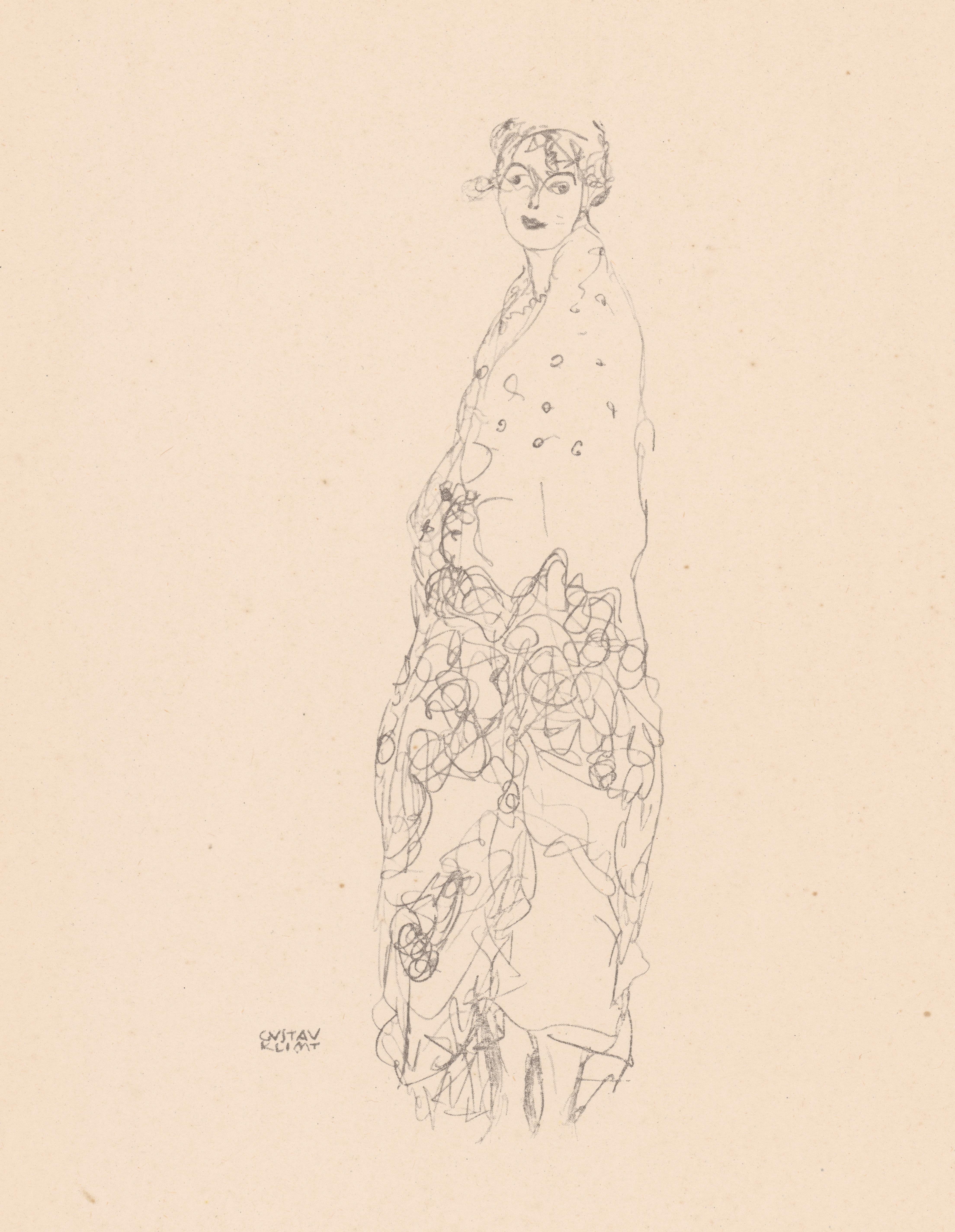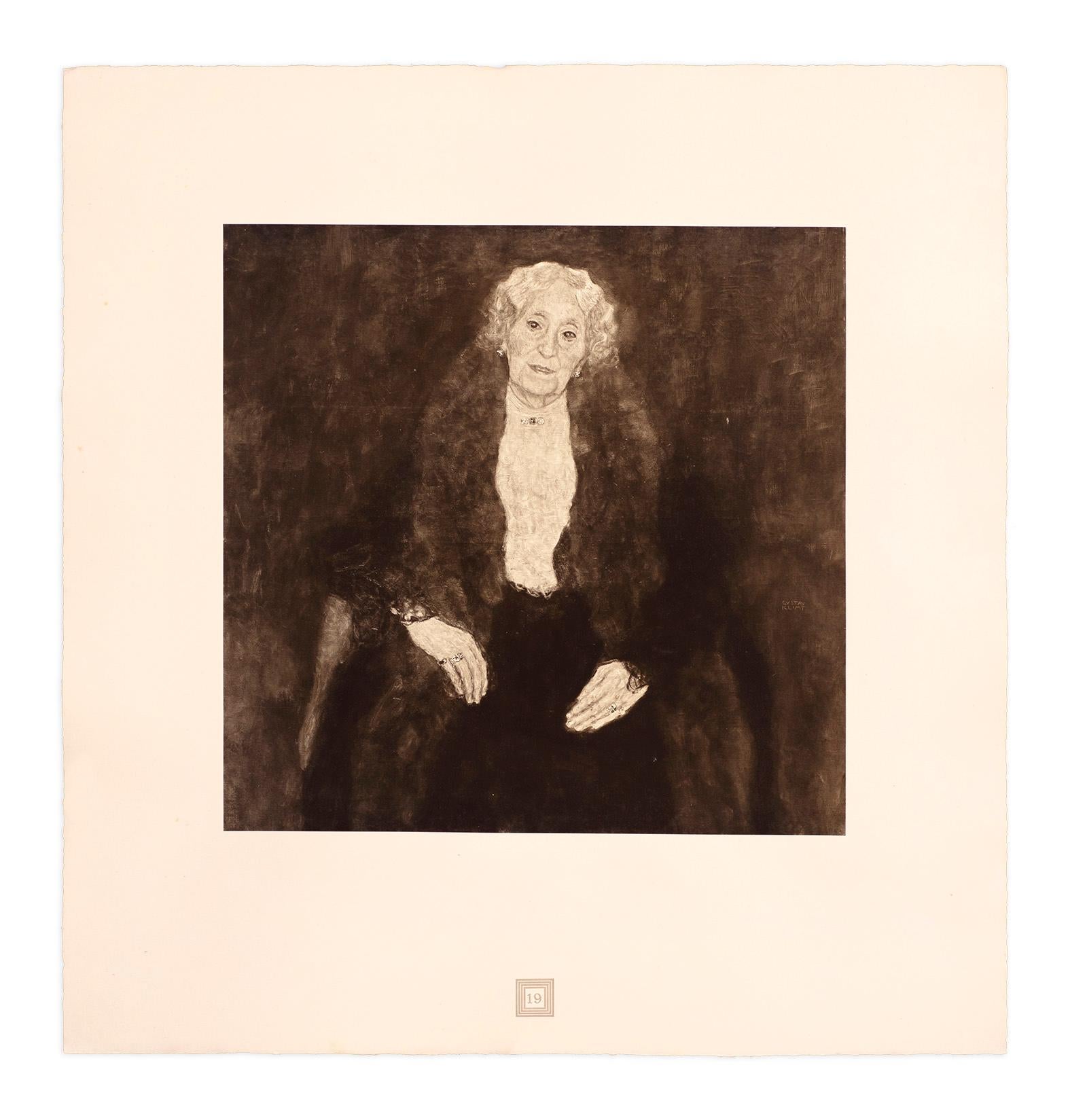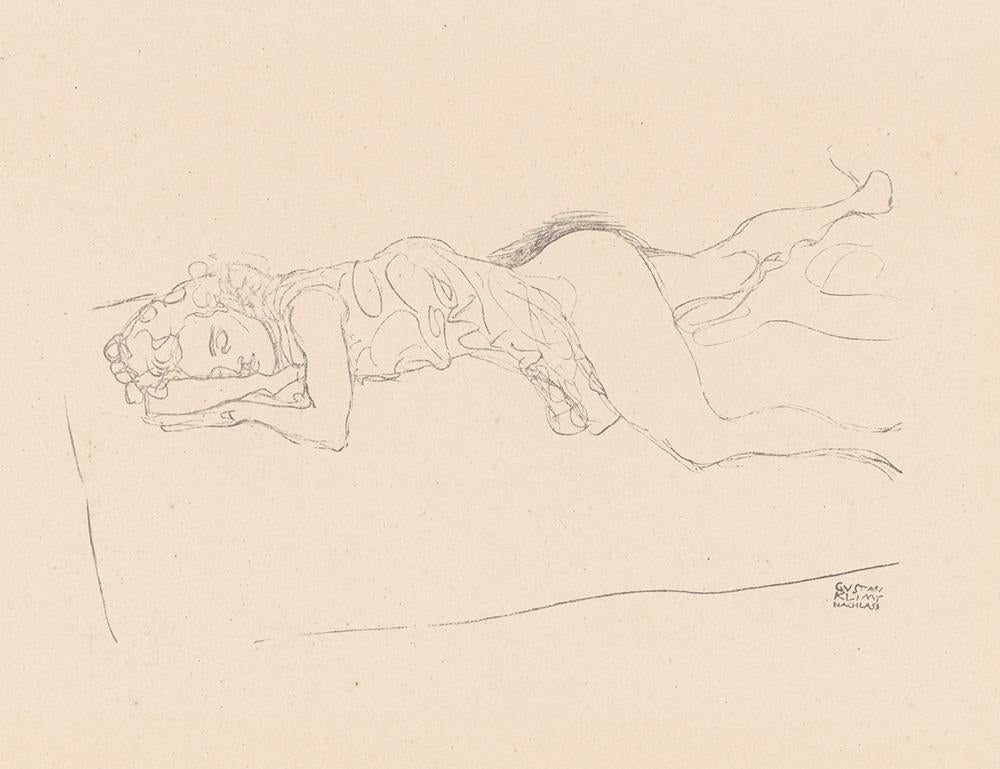Items Similar to Schloss Kammer Lake Attersee II by Gustav Klimt, Das Werk collotype, 1908-1912
Want more images or videos?
Request additional images or videos from the seller
1 of 6
Gustav KlimtSchloss Kammer Lake Attersee II by Gustav Klimt, Das Werk collotype, 1908-19121908-1914
1908-1914
About the Item
Original collotype created from Gustav Klimt’s Schloss Kammer on Lake Attersee II (Das Werk Gustav Klimts), originally painted in 1909. Published and edited by Verlag H.O. Miethke and printed by k.k. Hof- und Staatsdruckerei, Vienna, in an edition of 300.
Between 1908 and 1914, H.O. Miethke published Das Werk Gustav Klimts, a folio of collotypes representing Gustav Klimt’s most notable works leading up to 1913. Klimt’s original oil paintings were painstakingly reproduced as collotypes on a handmade, deckled-edge cream wove paper using a complex gravure process overseen by master technicians as well as the artist himself. Each image presented in the folio was assigned its own unique signet, which was designed by Klimt and struck below the image using a technique similar to letterpress. The signet corresponded to a matching signet in the justification page which detailed the piece’s size, location, and owner.
Published under the artist’s direct supervision, this series allowed Klimt, who had completely divorced himself from public commissions following the outcry from his University of Vienna paintings, to more effectively present his artworks to institutions and patrons across the world. A testament to the masterful design and printmaking demonstrated by Das Werk Gustav Klimts, Emperor Franz Joseph himself purchased the first copy of the folio.
Schloss Kammer on Lake Attersee II is an extraordinary example of the collotype process, capturing the superb resolution and detail of the original 1909 oil painting.
Century Guild has curated collections of Gustav Klimt’s printed works on paper for over twenty years, and this artwork arrives accompanied by a certificate of authenticity. Please contact us directly if you’d like to learn more about this artwork.
- Creator:Gustav Klimt (1862 - 1918, Austrian)
- Creation Year:1908-1914
- Dimensions:Height: 18 in (45.72 cm)Width: 18.5 in (46.99 cm)Depth: 0.1 in (2.54 mm)
- Medium:
- Movement & Style:
- Period:
- Condition:Exceptional condition commensurate with age. Image is pristine and will display beautifully.
- Gallery Location:Chicago, IL
- Reference Number:
Gustav Klimt
Gustav Klimt was an Austrian symbolist painter and a prominent member of the Vienna Secession movement. Klimt's primary subject was the female body and his works are mostly erotic in nature.
About the Seller
5.0
Vetted Seller
These experienced sellers undergo a comprehensive evaluation by our team of in-house experts.
Established in 1999
1stDibs seller since 2021
34 sales on 1stDibs
Typical response time: 1 hour
- ShippingRetrieving quote...Ships From: Chicago, IL
- Return PolicyThis item cannot be returned.
More From This SellerView All
- Seated woman with shawl, Gustav Klimt Handzeichnungen (Sketch), 1922By (after) Gustav KlimtLocated in Chicago, ILOriginal collotype lithograph of Gustav Kilmt’s Seated woman with shawl, published in the 1922 Handzeichnungen portfolio by Thyrsos Verlag, Leipzig and Vienna, in an edition of 375. This artwork is presented in archival rag mat and arrives accompanied by a certificate of authenticity. Klimt’s mastery of depth is most evident in the gentleness of his linework. Without the aid of shadow or the subtlety of values, the gestures of line allow the viewer a sense of a three-dimensional person or object. The meticulous lithographic process used to create Klimt’s Handzeichnungen portfolio ensures exceptionally crisp markings bearing a strong resemblance to the original sketches. This series showcases the quintessence behind Klimt’s signature visual style. This artwork arrives accompanied by a certificate of authenticity. Century Guild has curated collections of Gustav Klimt’s printed...Category
1920s Vienna Secession Prints and Multiples
MaterialsLithograph, Paper
- Seated nude, Gustav Klimt Handzeichnungen (Sketch), Thyrsos Verlag, 1922By (after) Gustav KlimtLocated in Chicago, ILOriginal collotype lithograph of Gustav Kilmt’s Seated nude, published in the 1922 Handzeichnungen portfolio by Thyrsos Verlag, Leipzig and Vienna, in an edition of 375. This artwork is presented in archival rag mat and arrives accompanied by a certificate of authenticity. Klimt’s mastery of depth is most evident in the gentleness of his linework. Without the aid of shadow or the subtlety of values, the gestures of line allow the viewer a sense of a three-dimensional person or object. The meticulous lithographic process used to create Klimt’s Handzeichnungen portfolio ensures exceptionally crisp markings bearing a strong resemblance to the original sketches. This series showcases the quintessence behind Klimt’s signature visual style. This artwork arrives accompanied by a certificate of authenticity. Century Guild...Category
1920s Vienna Secession Prints and Multiples
MaterialsLithograph, Paper
- Woman in dress, Gustav Klimt Handzeichnungen (Sketch), Thyrsos Verlag, 1922By (after) Gustav KlimtLocated in Chicago, ILOriginal collotype lithograph of Gustav Kilmt’s Woman in dress, published in the 1922 Handzeichnungen portfolio by Thyrsos Verlag, Leipzig and Vienna, i...Category
1920s Vienna Secession Prints and Multiples
MaterialsLithograph, Paper
- Portrait of Charlotte Pulitzer, Gustav Klimt An Aftermath collotype, 1931By (after) Gustav KlimtLocated in Chicago, ILOriginal 1931 collotype created from Gustav Kilmt’s Portrait of Charlotte Pulitzer, oil on canvas, 1915. Published by Max Eisler and printed by Österreichischer Staatsdruckerei (Austrian State Printing Office), Vienna, in an edition of 500. In 1931, Max Eisler published the most notable posthumous collection of Gustav Klimt works to date. Using a complex gravure process, Klimt’s original...Category
1930s Vienna Secession Prints and Multiples
MaterialsPaper
- Italian Garden Landscape, Gustav Klimt An Aftermath collotype, 1931By (after) Gustav KlimtLocated in Chicago, ILOriginal 1931 collotype created from Gustav Kilmt’s Italian Garden Landscape, oil on canvas, 1913. Published by Max Eisler and printed by Österreichischer Staatsdruckerei (Austrian State Printing Office), Vienna, in an edition of 500. In 1931, Max Eisler published the most notable posthumous collection of Gustav Klimt works to date. Using a complex gravure process, Klimt’s original...Category
1930s Vienna Secession Prints and Multiples
MaterialsPaper
- Female semi-nude on bedding, Gustav Klimt Handzeichnungen (Sketch), 1922By (after) Gustav KlimtLocated in Chicago, ILOriginal collotype lithograph of Gustav Kilmt’s Female semi-nude on bedding, published in the 1922 Handzeichnungen portfolio by Thyrsos Verlag, Leipzig and Vienna, in an edition of 375. This artwork is presented in archival rag mat and arrives accompanied by a certificate of authenticity. Klimt’s mastery of depth is most evident in the gentleness of his linework. Without the aid of shadow or the subtlety of values, the gestures of line allow the viewer a sense of a three-dimensional person or object. The meticulous lithographic process used to create Klimt’s Handzeichnungen portfolio ensures exceptionally crisp markings bearing a strong resemblance to the original sketches. This series showcases the quintessence behind Klimt’s signature visual style. This artwork arrives accompanied by a certificate of authenticity. Century Guild has curated collections of Gustav Klimt’s printed...Category
1920s Vienna Secession Prints and Multiples
MaterialsLithograph, Paper
You May Also Like
- Gerlach's Allegorien Plate #47: "Morning in the Spring" LithographBy Koloman MoserLocated in Chicago, ILKoloman Moser (1868 –1918), AUSTRIAN Instead of applying his flair and art education solely to painting, Koloman Moser embodied the idea of Gesamt Kunstwerk (all-embracing art work) by designing architecture, furniture, jewelry, graphics, and tapestries meant to coordinate every detail of an environment. His work transcended the imitative decorative arts of earlier eras and helped to define Modernism for generations to come. Moser achieved a remarkable balance between intellectual structure (often geometric) and hedonistic luxury. Collaborating with Gustav Klimt and Josef Hoffmann, the artist was an editor and active contributor to Ver Sacrum, (Sacred Spring), the journal of the Viennese Secession that was so prized for its aesthetics and high quality production that it was considered a work of art. The magazine featured drawings and designs in the Jugendstil style (Youth) along with literary contributions from distinguished writers from across Europe. It quickly disseminated both the spirit and the style of the Secession. In 1903 Moser and Hoffmann founded and led the Wiener Werkstatte (Viennese Workshop) a collective of artisans that produced elegant decorative arts items, not as industrial prototypes but for the purpose of sale to the public. The plan, as idealistic then as now, was to elevate the lives of consumers by means of beautiful and useful interior surroundings. Moser’s influence has endured throughout the century. His design sensibility is evident from the mid-century modern furniture of the 1950s and ‘60s to the psychedelic rock posters...Category
1890s Vienna Secession Figurative Prints
MaterialsPaper
- E. Strache, Handzeichnungen folio, "Nursing Mother with Child" Collotype plateBy (after) Egon SchieleLocated in Chicago, ILafter Egon Schiele (1890 – 1918), AUSTRIA “ART CANNOT BE MODERN, ART IS PRIMORDIALLY ETERNAL.” -SCHIELE Defiantly iconoclastic in life and art, Egon Schiele is esteemed for his mas...Category
1920s Vienna Secession Figurative Prints
MaterialsPaper
- H.O. Miethke Das Werk folio "The Great Poplar II (Thunderstorm)" collotype printBy Gustav Klimt & K.K. Hof-und StaatsdruckereiLocated in Chicago, ILDAS WERK GUSTAV KLIMTS, a portfolio of 50 prints, ten of which are multicolor collotypes on chine colle paper laid down on hand-made heavy cream wove paper with deckled edges; under ...Category
Early 1900s Vienna Secession Landscape Prints
MaterialsPaper
- Max Eisler Eine Nachlese folio "Litzlberg on Lake Attersee" collotypeBy (after) Gustav KlimtLocated in Chicago, ILAfter Gustav Klimt, Max Eisler Plate #8, Litzlberg on Lake Attersee; blue monochrome collotype after the 1915 painting in oil on canvas. GUSTAV KLIMT EINE NACHLESE (GUSTAV KLIMT AN ...Category
1930s Vienna Secession Landscape Prints
MaterialsPaper
- Max Eisler Eine Nachlese folio “Garden Path with Chickens” collotype printBy (after) Gustav KlimtLocated in Chicago, ILAfter Gustav Klimt, Max Eisler #26, Bauerngarten mit Hühnern; multi-color collotype after 1916 painting in oil on canvas. The original was destroyed by fire in May 1945 at Immendorf Castle, Lower Austria. Landscapes, for Klimt, are vehicles to convey universal themes such as procreation and the mysteries of life. Using a highly personal language of symbols, Klimt creates a voluptuous scene of fertility, fecundity and domesticity. Klimt uses a similarly lustrous palette of pearly iridescence for the path as he had for many of his female nudes. This feminine quality is intensified by the tunnel-effect produced by the walls of colorful floral blooms whose leafy stalks are redolent with wild abundance at the height of summer.The passage leads to a green covered arbor, womb-like, which contains a simple wooden table and a bench. Human presence is unmistakeable.The two chickens shown in the path provide the link to engage with this scene cerebrally and emotionally. Protective and maternal, the mother hens do somewhat bar one’s path, but by no means in a menacing way. The experiential aspect of walking forward and ignoring those chickens, certain that they will dodge out of the way, heightens the rational with the intuitive senses creating the illusion and feeling that the flanking floral walls are parting to provide clear passage to within. Seen in this context, the age old conundrum to divine what came first, the chicken or the egg, begs the question of the greatest mystery of all. One’s relationship to procreation itself, Klimt shows us, is interwoven all around us. Far from banal, this universal quality of the natural world is fraught with thrilling wonder. GUSTAV KLIMT EINE NACHLESE (GUSTAV KLIMT AN AFTERMATH), a portfolio of 30 collotypes prints, 15 are multi-color and 15 are monochrome, on chine colle paper laid down on heavy cream-wove paper with deckled edges; Max Eisler, Editor-Publisher; Osterreichischer Staatsdruckerei (Austrian State Printing Office), Printer; in a limited edition of 500 numbered examples of which: 200 were printed in German, 150 were printed in French and 150 were printed in English; Vienna, 1931. 2018 marks the 100th anniversary of Gustav Klimt’s death. It is a fitting time to reflect upon the enduring legacy and deep impact of his art. Recognizing this need for posterity with uncanny foresight, the publication of Gustav Klimt: An Aftermath (Eine Nachlese) provides a rare collection of work after Klimt which has proven to be an indispensable tool for Klimt scholarship as well as a source for pure visual delight. Approximately 25 percent of the original works featured in the Aftermath portfolio have since been lost. Of those 30, six were destroyed by fire on 8 May 1945. On that fateful final day of WWII, the retreating Feldherrnhalle, a tank division of the German Army, set fire to the Schloss Immendorf which was a 16th century castle in Lower Austria used between 1942-1945 to store objects of art. All three of Klimt’s Faculty Paintings: Philosophy, Medicine and Jurisprudence (1900-1907), originally created for the University of Vienna, were on premises at that time. Also among the inventory of Klimt paintings in storage there was art which had been confiscated by the Nazis. One of the most significant confiscated collections was the Lederer collection which featured many works by Gustav Klimt such as Girlfriends II and Garden Path with Chickens...Category
1930s Vienna Secession Landscape Prints
MaterialsPaper
- H.O. Miethke Das Werk folio "Portrait of Gertha Felsövanyi" collotype printBy Gustav Klimt & K.K. Hof-und StaatsdruckereiLocated in Chicago, ILDAS WERK GUSTAV KLIMTS, a portfolio of 50 prints, ten of which are multicolor collotypes on chine colle paper laid down on hand-made heavy cream wove paper with deckled edges; under ...Category
Early 1900s Vienna Secession Figurative Prints
MaterialsPaper
Recently Viewed
View AllMore Ways To Browse
Klimt Original
Gustav Klimt Original
Klimt Secession
Klimt University
1900 Vienna Painting
Das Werks
Das Werk
Gustav Klimt Collotype
Klimt Collotypes
Gustav Klimt Original Artwork
Cream Lake
Das Werk Gustav Klimts
Das Werk Klimt
Gustav Klimt Das Werk
Klimt Das Werk
Antique Letterpress
Letterpress Antique
Klimt Miethke






